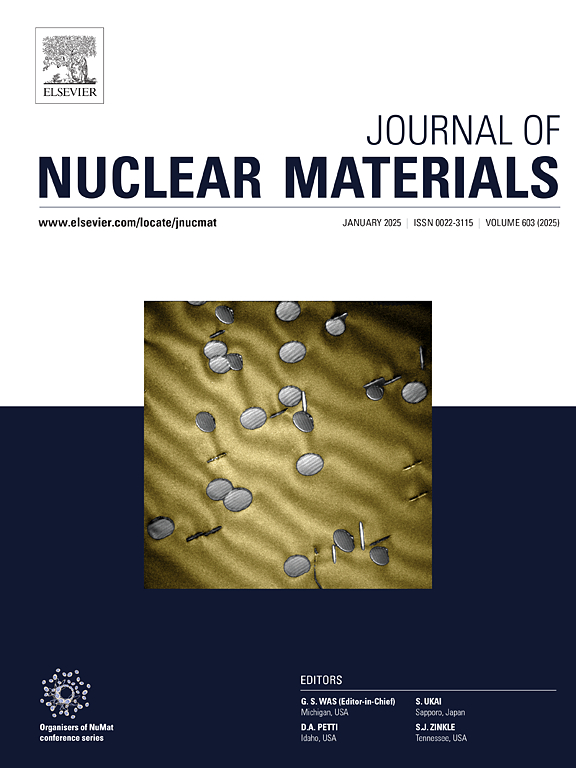Oxidation resistance of high-burnup Cr-doped UO2 accident tolerant fuel and comparison with irradiated UO2
IF 2.8
2区 工程技术
Q3 MATERIALS SCIENCE, MULTIDISCIPLINARY
引用次数: 0
Abstract
The oxidation behaviour of a high-burnup Cr-doped UO2 fuel under dry interim storage conditions has been in-situ analysed by Raman spectroscopy. In particular, this shortest-term accident tolerant fuel (ATF) has been subjected to 350 ºC in air for about 1000 h and its oxidation reaction compared to that of a UO2 spent fuel irradiated in the same conditions and exposed to the same thermal treatment. The results obtained here do not only sustain the previous observation of a delay in U3O8 formation in the outer periphery (rim area), compared to the pellet centre for high-burnup spent fuels, but they also prove for the first time the greater resistance of this irradiated ATF to the complete oxidation of its UO2 matrix. These findings have been confirmed with a further test of the Cr-doped UO2 fuel at 400 ºC, where its significant heterogeneity has been additionally noticed by the continuous acquisition of Raman spectra in different regions of the pellet.

高燃耗掺铬UO2耐事故燃料的抗氧化性能及与辐照UO2的比较
用拉曼光谱法原位分析了高燃耗cr掺杂UO2燃料在干贮存条件下的氧化行为。特别是,与UO2乏燃料在相同条件下辐照并暴露于相同热处理的氧化反应相比,这种短期耐事故燃料(ATF)已在空气中350ºC中放置约1000小时。与高燃耗乏燃料的颗粒中心相比,这里获得的结果不仅支持了先前观察到的外边缘(边缘区域)U3O8形成延迟,而且还首次证明了这种辐照ATF对其UO2基质的完全氧化具有更大的抵抗力。在400℃下对掺铬UO2燃料的进一步测试证实了这些发现,在颗粒的不同区域连续获得拉曼光谱,进一步注意到其显著的非均质性。
本文章由计算机程序翻译,如有差异,请以英文原文为准。
求助全文
约1分钟内获得全文
求助全文
来源期刊

Journal of Nuclear Materials
工程技术-材料科学:综合
CiteScore
5.70
自引率
25.80%
发文量
601
审稿时长
63 days
期刊介绍:
The Journal of Nuclear Materials publishes high quality papers in materials research for nuclear applications, primarily fission reactors, fusion reactors, and similar environments including radiation areas of charged particle accelerators. Both original research and critical review papers covering experimental, theoretical, and computational aspects of either fundamental or applied nature are welcome.
The breadth of the field is such that a wide range of processes and properties in the field of materials science and engineering is of interest to the readership, spanning atom-scale processes, microstructures, thermodynamics, mechanical properties, physical properties, and corrosion, for example.
Topics covered by JNM
Fission reactor materials, including fuels, cladding, core structures, pressure vessels, coolant interactions with materials, moderator and control components, fission product behavior.
Materials aspects of the entire fuel cycle.
Materials aspects of the actinides and their compounds.
Performance of nuclear waste materials; materials aspects of the immobilization of wastes.
Fusion reactor materials, including first walls, blankets, insulators and magnets.
Neutron and charged particle radiation effects in materials, including defects, transmutations, microstructures, phase changes and macroscopic properties.
Interaction of plasmas, ion beams, electron beams and electromagnetic radiation with materials relevant to nuclear systems.
 求助内容:
求助内容: 应助结果提醒方式:
应助结果提醒方式:


